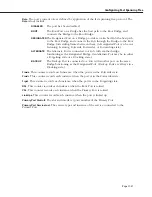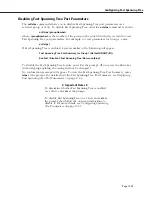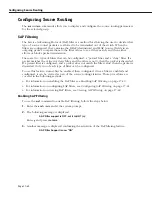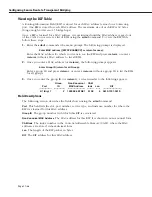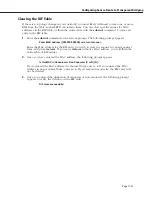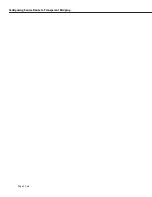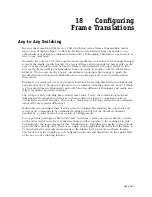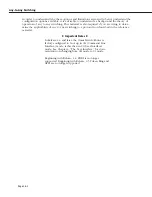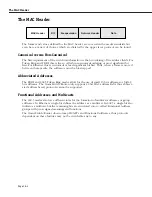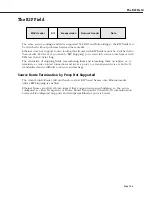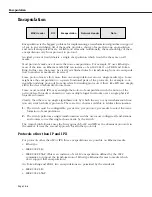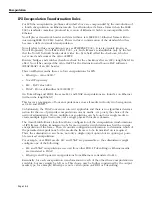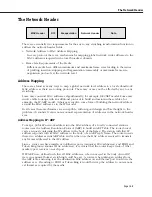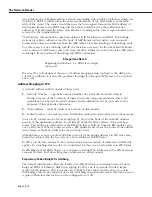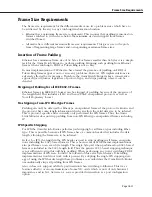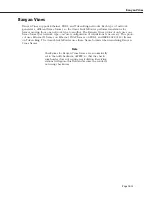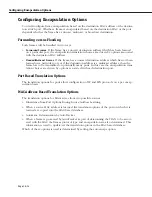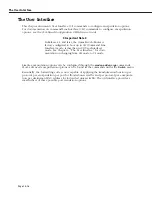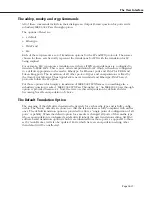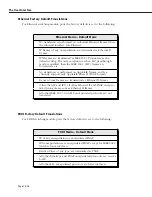
Translating the Frame
Page 18-3
Translating the Frame
In order to discuss these issues independent of particular media and protocols, consider that
every frame, of any protocol, on any media, consists of the following parts.
The Essential Parts of Frame
MAC Header
Consists of a source and destination address specifying the transmitting station in the broad-
cast domain and the intended recipient(s), as well as other media specific fields. For exam-
ple, AC and FC fields in Token Ring, FC in FDDI, etc.
RIF (Router Information Field)
If present, it is defined by the source routing standard and is only found on Token Ring and
FDDI media.
Encapsulation
Defined by the various standards for the media, many of which reference common standards.
For example, on Ethernet media, as defined by Ethernet II, this is a 16 bit type field. On
Ethernet media, as defined by the IEEE 802.3 committee, this is a length field together with
any encapsulation defined by the IEEE 802.2 Logical Link Control (LLC) committee. On Token
Ring and FDDI, it is any encapsulation defined by the IEEE 802.2 LLC committee.
Network Header
Defined by the organization responsible for the particular routing protocol whose data is
being carried within the frame. The values of fields defined in the Encapsulation area allow
the recipient to identify which protocol standard to use to decode the Network Header part of
the frame.
Data
The payload being carried between the end-stations.
In a routing implementation the first three fields (i.e., MAC header, RIP, and Encapsulation)
are the ones stripped and rebuilt when the frame is forwarded. These are the three areas that
have to be manipulated. The next sections examine each of these frame packet areas further
to see the media and protocol dependencies. We can also examine their interactions.
MAC Header
RIF
Encapsulation
Network Header
Data
Summary of Contents for Omni Switch/Router
Page 1: ...Part No 060166 10 Rev C March 2005 Omni Switch Router User Manual Release 4 5 www alcatel com ...
Page 4: ...page iv ...
Page 110: ...WAN Modules Page 3 40 ...
Page 156: ...UI Table Filtering Using Search and Filter Commands Page 4 46 ...
Page 164: ...Using ZMODEM Page 5 8 ...
Page 186: ...Displaying and Setting the Swap State Page 6 22 ...
Page 202: ...Creating a New File System Page 7 16 ...
Page 270: ...Displaying Secure Access Entries in the MPM Log Page 10 14 ...
Page 430: ...OmniChannel Page 15 16 ...
Page 496: ...Configuring Source Route to Transparent Bridging Page 17 48 ...
Page 542: ...Dissimilar LAN Switching Capabilities Page 18 46 ...
Page 646: ...Application Example DHCP Policies Page 20 30 ...
Page 660: ...GMAP Page 21 14 ...
Page 710: ...Viewing the Virtual Interface of Multicast VLANs Page 23 16 ...
Page 722: ...Application Example 5 Page 24 12 ...
Page 788: ...Viewing UDP Relay Statistics Page 26 24 ...
Page 872: ...The WAN Port Software Menu Page 28 46 ...
Page 960: ...Deleting a PPP Entity Page 30 22 ...
Page 978: ...Displaying Link Status Page 31 18 ...
Page 988: ...Displaying ISDN Configuration Entry Status Page 32 10 ...
Page 1024: ...Backup Services Commands Page 34 14 ...
Page 1062: ...Diagnostic Test Cable Schematics Page 36 24 ...
Page 1072: ...Configuring a Switch with an MPX Page A 10 ...
Page 1086: ...Page B 14 ...
Page 1100: ...Page I 14 Index ...

